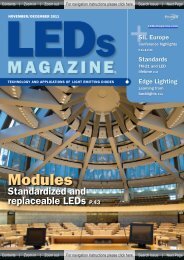Zoom In - Beriled
Zoom In - Beriled
Zoom In - Beriled
- No tags were found...
Create successful ePaper yourself
Turn your PDF publications into a flip-book with our unique Google optimized e-Paper software.
Previous Page | Contents | <strong>Zoom</strong> in | <strong>Zoom</strong> out | Front Cover | Search Issue | Next PageABE FMaGSlighting | DIRECTIONALa)b)FIG. 3. Typical beam patterns from (a) amulti-emitter vs. (b) a single emitter.LED products must maintain a power factor> 0.9 to be acceptable in commercialinstallations.Dimming capabilities: <strong>In</strong>dividual LEDsare capable of dimming ranges from 100%to 0% through the traditional use of pulsewidthmodulation (PWM). However, for generallighting, it is best to work with commercially-availableoffline wall dimmers. Walldimmers adjust power to the lighting systemand have been designed for halogenloads >20 W. LED MR16 solutions typicallyrun in the 6–7 W range. This can lead to limiteddimming capabilities, flickering at lowdimming levels and non-start of the transformer.Wall dimmers have a turn-on thresholdaround 3 W, so a 20 W halogen lamp canbe dimmed down to about 15%. With LEDlamps, this threshold translates dimmingto 30–40%. This is true for single LED lampson a dimmer, but multiple lamps on a singletransformer/dimmer will reach lower dimminglevels as the load increases.Thermal considerations: LED productsare more efficient than their incandescentcounterparts and require a unique approachto thermal management. Rather than theradiated heat from the infrared energy thatincandescent sources emit, most of the LEDheat is generated from the LED die and mustbe conducted away. LED packaging technologyis becoming a key part of the overallthermal solution. Designs that managethe heat most efficiently can extend the limitsof the system and increase the light outputwithout sacrificing long-term reliability.Depending on the size or power of thelamp, there will either be passive or activecooling. Passive cooling is simply a relativelylarge metal heat sink, usually withfins to increase the metal surface area forbetter heat dissipation. Active cooling solutionscan be fans or a diaphragm. Passivelycooled solutions are quiet but somewhatbulky, while active cooling systems allowfor a more compact stylish light module.The future is bright with LEDs.Optical efficiency is the challenge.Fusion Optix is the solution.Fusion Optix optical components are designed for maximumlight control with minimal light loss, resulting in highly effi cientLED lighting systems appropriate for architectural lighting andgeneral illumination.• Diffusion Lenses offer versatility and control, whilemaintaining high optical effi ciencies• Light Guides enable ultra-slim form factors and uniform lightdistribution• LED Assemblies are precisely binned and thermally managedto provide color uniformity and long lifetime• Fusion Optix offers rapid cost effective prototyping andcustomization services for OEMs in order to bring innovativeproducts to market quicklyFusion Optix, <strong>In</strong>c. • 19 Wheeling Avenue • Woburn, MA 01801 • +1 866.506.8300 • www.fusionoptix.com38 APRIL 2009 LEDsmagazine.comPrevious Page | Contents | <strong>Zoom</strong> in | <strong>Zoom</strong> out | Front Cover | Search Issue | Next PageABE FMaGS

















